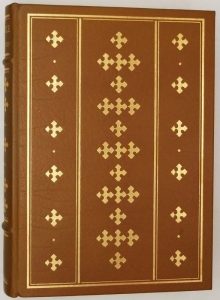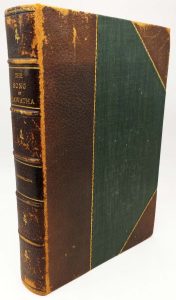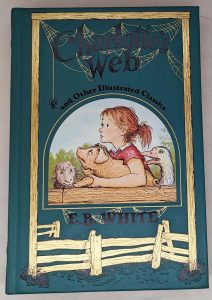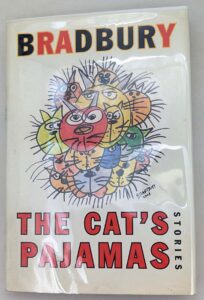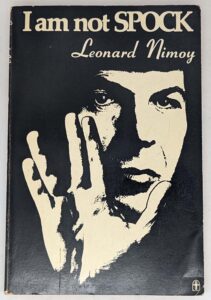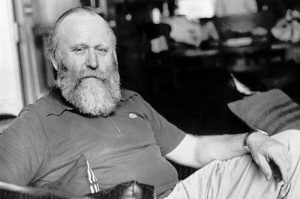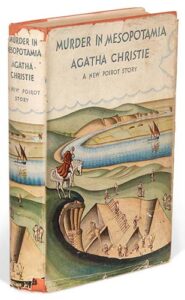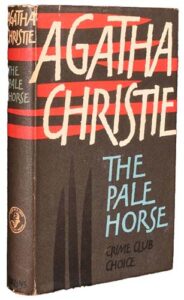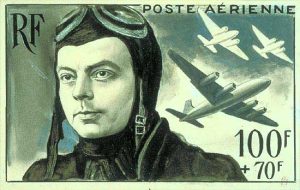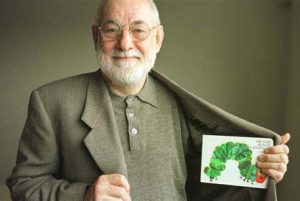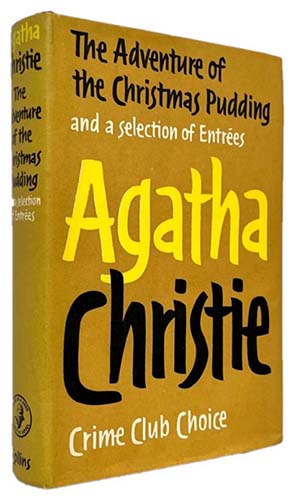
The Adventure of the Christmas Pudding and a Selection of Entrées is a short story collection written by Agatha Christie and first published in the UK by the Collins Crime Club on 24 October 1960. It is the only Christie first edition published in the UK that contains stories with both Hercule Poirot and Miss Marple, the writer’s two most famous detectives. It retailed in the UK for twelve shillings and sixpence (12/6) and comprises six cases. It was not published in the US although the stories it contains were published in other volumes there.
References to other works:
- Dr Stillingfleet who plays a role in “The Dream” later appears in the full-length Hercule Poirot mystery, Third Girl.
- Poirot’s reference to believing “six impossible things before breakfast” in The Adventure of the Christmas Pudding is a quotation from chapter 5 of Through the Looking-Glass by Lewis Carroll when Alice says that she cannot believe in impossible things and the White Queen replies that she hasn’t had enough practice and that she, “always did it for half-an-hour a day. Why, sometimes I’ve believed as many as six impossible things before breakfast”.
Plot Summary
[SPOILER ALERT]
Poirot is asked by a Mr Jesmond, who is acting as an intermediary to an eastern prince, to help that unfortunate young man with a problem he is having. The prince is due soon to be married to a cousin.
On his way to be married, he met an attractive but obviously dubious young woman, and rashly decided to have a last fling with her. The prince brought several expensive jewels with him to London for resetting by Cartier and one of them, a fabulous ruby, was stolen by the young woman. If it cannot be retrieved, a scandal will ensue and because of this, the police cannot be involved. The mystery can be solved at an old English country house called Kings Lacey where it will be arranged for Poirot to join a family there for their Christmas celebrations, supposedly to experience a typical English Christmas.
On Christmas Eve, at Kings Lacey, Poirot is told about the other members of their party by Mrs Lacey, his elderly host in the house. Joining them will be her husband, Colonel Lacey; Sarah, a granddaughter by their deceased son; Colin, a teenage grandson by their daughter; Michael, a friend of Colin’s at school; Bridget who is of the same age as Colin and Michael and is a great niece of Mrs Lacey’s; Diana, a young cousin of Mrs Lacey’s; and David Welwyn who is a family friend.
Colonel and Mrs Lacey are perturbed by Sarah’s relationship with a young rake called Desmond Lee-Wortley. They both think him unsuitable for their granddaughter and have invited him to join them for Christmas, in the hope that a few days’ close contact with Sarah will show her how unsuitable he is, particularly in contrast to David Welwyn who has been friends with Sarah since childhood. Lee-Wortley is there with his sister who is recovering from an operation and is confined to her room, convalescing.
Colin, Michael, and Bridget are disappointed with Poirot as he does not meet their expectations of what a detective should look like. They hatch a plan to arrange a false murder for Poirot to detect with Bridget lying in the snow with blood as the “dead” body and footprints leading through the snow which is now falling and expected to grow heavier. They decide that they will put their plan into operation on Boxing Day, as Colonel Lacey would not like something of that nature to take place on Christmas Day itself.
That night, the Christmas tree is decorated and the party retire to their rooms for the night. On his pillow, Poirot finds a scrawled note which reads, “DON’T EAT NONE OF THE PLUM PUDDING. ONE WHO WISHES YOU WELL.” He is most puzzled.
The next day, the party eats a huge Christmas dinner, and then the elderly and partly retired butler brings in the Christmas pudding with great ceremony. The diners find the usual tokens in their portions, but the Colonel is annoyed and amazed when he almost chokes on a piece of red glass in his. Poirot takes the object and pockets it. Afterwards, Poirot visits the kitchen to compliment the daily cook, Mrs Ross, on the meal and particularly the pudding. She confesses that two were made, one for that day and one for New Year’s Day, but the one for Christmas Day was dropped and the one for six days later substituted in its place.
That night, Poirot pretends to sleep in his bed, having avoided drinking a drugged coffee which had been handed to him by Lee-Wortley. A figure enters his room and conducts a fruitless search.
The next morning, the children carry out their “murder” plan and rouse Poirot from his bed to investigate the “dead” body but the planners get a shock when Poirot confirms that Bridget is indeed dead, Sarah and Lee-Wortley having joined them in the snow. Poirot invites the young man to check Bridget’s pulse and he confirms there isn’t one.
Poirot points out that the footprints in the snow look like Lee-Wortley’s and that in the dead girl’s hand is the glass “ruby” from the pudding. Lee-Wortley is dumbfounded but, taking the glass, offers to ring for the police. Claiming to Diana that the phone is dead, he drives off to fetch them.
Poirot takes the others in the house where he explains all. He tells them that Lee-Wortley is a blackmailer and involved in other questionable matters. His supposed sister is the young woman who took the ruby from the eastern prince, and the two of them were tracked to Kings Lacey.
Bridget appears in the room — she is not dead, having worn a tourniquet on her arm when lying in the snow, and was in league with Poirot to trick Lee-Wortley. Poirot heard the children planning their “murder” through an open window and used this opportunity to take Lee-Wortley in. The “ruby” that Bridget held in the snow was a paste copy that Poirot brought with him to the house, and Lee-Wortley has taken this with him. Poirot supposes that he will go abroad, where he will be surprised when he tries to sell the false jewel. The real ruby was hidden by the two thieves in what they were told was the New Year pudding, and they were unaware of the accident that befell the pudding intended for Christmas Day.
Lee-Wortley’s “sister” overhears this and is furious that her co-conspirator has left her to face the music. She too flees the house. The mystery of who left the note on Poirot’s pillow is solved when one of the housemaids confesses that she heard Lee-Wortley and his “sister” discussing getting Poirot out of the way and that something had been put in the pudding, causing her to think they planned to poison him. He rewards her by promising her a vanity box, and gets a kiss from Bridget under the mistletoe.
Publication history
- 1960, Collins Crime Club (London), 24 October 1960, Hardback, 256 pp
- 1963, Fontana (Imprint of HarperCollins), Paperback, 224 pp
First publication of stories
- “The Adventure of the Christmas Pudding” is an expanded version of the story of the same name which appeared in issue 1611 of The Sketch magazine on 12 December 1923. The original shorter version was first printed in book form in the UK in two obscure collections Problem at Pollensa Bay and Christmas Adventure (Todd 1943) and Poirot Knows the Murderer (Polybooks 1946) and it was reprinted in book form in the UK collection While the Light Lasts and Other Stories in 1997 under the title “Christmas Adventure”. The expanded version appeared after publication of the book in the weekly magazine Women’s Illustrated from 24 December 1960 to 7 January 1961 under the alternative title of “The Theft of the Royal Ruby” with illustrations by Zelinksi. The story first appeared in the US in Double Sin and Other Stories in 1961 also under the title of “The Theft of the Royal Ruby” with some slight revisions to the UK version. The original shorter version has so far not been published in the US.
- “The Mystery of the Spanish Chest” is an expanded version of the story “The Mystery of the Baghdad Chest” which appeared in issue 493 of the Strand Magazine in January 1932. The original shorter version was reprinted in book form in the UK collection While the Light Lasts and Other Stories in 1997. The first publication of the expanded version was in three instalments in Women’s Illustrated from 17 September to 1 October 1960 with illustrations by Zelinksi. In the US, the shorter version was published in the Ladies Home Journal in January 1932 and the expanded version appeared in the US in The Harlequin Tea Set in 1997.
- “The Under Dog” was first published in the UK in The London Magazine in October 1926 although its first printing was in the US in Volume 8, Number 6 of The Mystery Magazine in April 1926. The story’s first appearance in book form was in the UK in 2 New Crime Stories, published by The Reader’s Library in September 1929 (the other story in the volume was “Blackman’s Wood” by E. Phillips Oppenheim).
- “Four and Twenty Blackbirds” was first published in the UK in the Strand Magazine in issue 603 in March 1941 under the title of “Poirot and the Regular Customer” and its first printing was in the US in the 9 November 1940 (Volume 106, Number 19)issue of Collier’s magazine.
- “The Dream” was first published in the UK in the Strand Magazine in issue 566 in February 1938.
- “Greenshaw’s Folly” was first published in the UK in the Daily Mail, 3–7 December 1956.
US book appearances of stories
- “The Mystery of the Baghdad Chest” (the earlier version of “The Mystery of the Spanish Chest”) and “The Dream” appeared in The Regatta Mystery.
- “The Under Dog” appeared in The Under Dog and Other Stories.
- “Four-and-Twenty Blackbirds” appeared in Three Blind Mice and Other Stories.
The Adventure of the Christmas Pudding – First Edition Book Identification Guide
The books are listed in the order of publication. While the majority of Agatha Christie’s books were first published in the UK. There are many titles that were first published in the US. The title of the book may differs from the UK edition in some cases.
| Year | Title | Publisher | First edition/printing identification points |
|---|---|---|---|
| 1960 | The Adventure of the Christmas Pudding | William Collins & Sons, London, [1960] | First edition. "© Agatha Christie, Ltd., 1959" stated on the copyright page. No statement of later printings. Red cloth lettered in black. No US edition. Price 12/6. |
Note about Book Club Editions (BCE) and reprints:
UK: You can see statements of later reprint dates or of book club on the copyright page.
US: The US reprint publishers usually use the same sheets as the first edition and are harder to identify by looking at the title page or the copyright page. One may identify a BCE by looking at the DJ, which doesn’t have a price on top of the front flap and a “Book Club Edition” imprint at the bottom. If the dust jacked is clipped at both the top/bottom of the front flap. You can safely assume it’s a BCE . If the book is missing the dust jacket. Later BCE editions can be identified by its plain boards, while first printings are issued in quarter cloth.
Please refer to the gallery for detailed images of true first edition bindings and dust jackets.
The Adventure of the Christmas Pudding – First Edition Dust Jacket Identification Guide
First edition bindings and various dust jacket printings identification.
